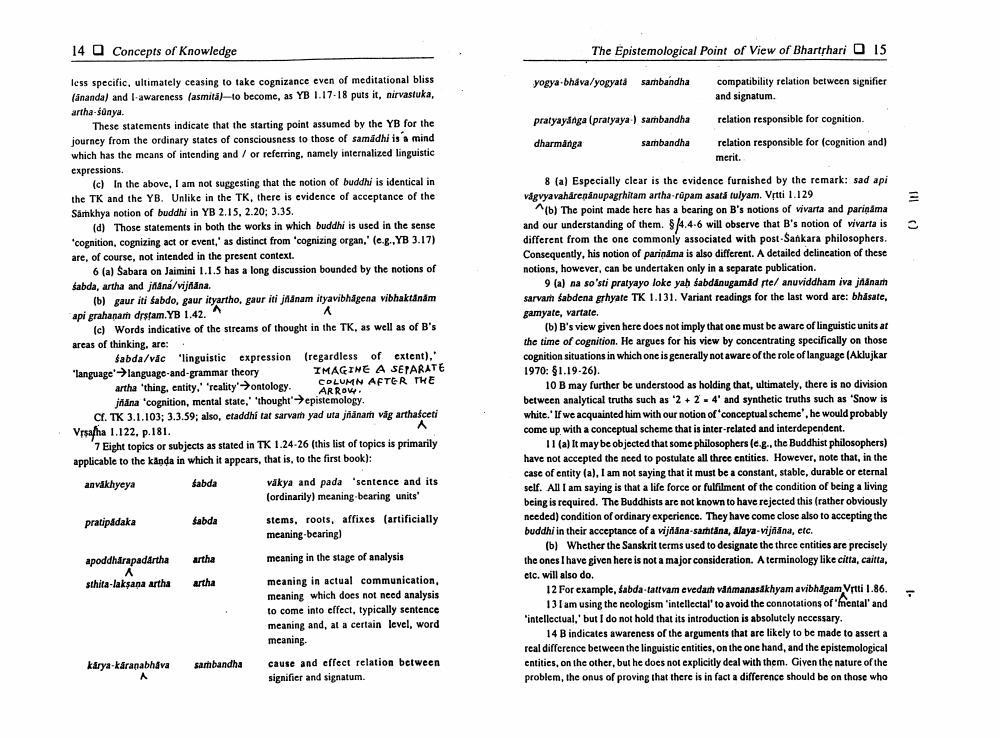Book Title: Epistemological Point Of View Of Bhartrhari Author(s): Ashok Aklujkar Publisher: Ashok Aklujkar View full book textPage 8
________________ 14 Concepts of Knowledge The Epistemological Point of View of Bharthari O 15 yogya-bhava/yogyatá sambandha compatibility relation between signifier and signatum. pratyayanga (pratyaya) sambandha relation responsible for cognition. dharmainga sambandha relation responsible for (cognition and) merit. less specific, ultimately ceasing to take cognizance even of meditational bliss (ananda) and I awareness (asmita)-lo become, as YB 1.17.18 puts it, nirvastuka. artha-súnya. These statements indicate that the starting point assumed by the YB for the journey from the ordinary states of consciousness to those of samadhi is a mind which has the means of intending and / or referring, namely internalized linguistic expressions. (c) In the above, I am not suggesting that the notion of buddhi is identical in the TK and the YB. Unlike in the TK, there is evidence of acceptance of the Sankhya notion of buddhi in YB 2.15.2.20: 3.35. (d) Those statements in both the works in which buddhi is used in the sense 'cognition, cognizing act or event,' as distinct from 'cognizing organ' (e.g.YB 3.17) are, of course, not intended in the present context. 6 (a) Sabara on Jaimini 1.1.5 has a long discussion bounded by the notions of sabda, artha and janá/vijnana. (b) gaur iti sabdo, gaur ityartho, gaur itinam ityavibhagena vibhaktandm api grahanam drsam. YB 1.42. (c) Words indicative of the streams of thought in the TK, as well as of B's areas of thinking, are: Sabda/vie "linguistic expression (regardless of extent), "language language-and-grammar theory IMAGINE A SEPARATE artha thing, entity.' 'reality' ontology. COLUMN AFTER THE jnana 'cognition, mental state,' thought' epistemology. C. TK 3.1.103; 3.3.59; also, ctaddhi tat sarvar yad utajnah wie arthasceti Vrsafha 1.122, p.181. 7 Eight topics or subjects as stated in TK 1.24-26 (this list of topics is primarily applicable to the kanda in which it appears, that is, to the first book): 8 (a) Especially clear is the evidence furnished by the remark: sad api vágvyavaharcnánupagrhitam artha rapam asata sulyam. Vrtti 1.129 (b) The point made here has a bearing on B's notions of vivarta and parinama and our understanding of them. 514.4-6 will observe that B's notion of vivartais different from the one commonly associated with post-Sankara philosophers. Consequently, his notion of parin ma is also different. A detailed delineation of these notions, however, can be undertaken only in a separate publication. 9 (a) na so'sti pratyayo loke yah sabdanugamad ste/ anuviddham iva janam sarvash sabdena grhyate TK 1.131. Variant readings for the last word are: bhasate, gamyate, vartate. (b) B's view given here does not imply that one must be aware of linguistic units at the time of cognition. He argues for his view by concentrating specifically on those cognition situations in which one is generally not aware of the role of language (Aklujkar 1970: $1.19-26). 10 B may further be understood as holding that, ultimately, there is no division between analytical truths such as 2 + 2 - 4' and synthetic truths such as 'Snow is white.' If we acquainted him with our notion of conceptual scheme, he would probably come up with a conceptual scheme that is inter-related and interdependent. 11 (a) It may be objected that some philosophers (e.g., the Buddhist philosophers) have not accepted the need to postulate all three entities. However, note that, in the case of entity (a), I am not saying that it must be a constant, stable, durable or eternal self. All I am saying is that a life force or fulfilment of the condition of being a living being is required. The Buddhists are not known to have rejected this (rather obviously needed) condition of ordinary experience. They have come close also to accepting the buddhi in their acceptance of a vijana-santana, alaya-vijñana, etc. (b) Whether the Sanskrit terms used to designate the three entities are precisely the ones I have given here is not a major consideration. A terminology like citta, caitta, etc. will also do. 12 For example, sabda-tattvam evedash va manasakhyam avibhagam Vrtti 1.86. 13 I am using the neologism intellectal' to avoid the connotations of friental and "intellectual," but I do not hold that its introduction is absolutely necessary. 14 B indicates awareness of the arguments that are likely to be made to assert a real difference between the linguistic entities, on the one hand, and the epistemological entitics, on the other, but he does not explicitly deal with them. Given the nature of the problem, the onus of proving that there is in fact a difference should be on those who anvåkhyeya Sabda vikya and pada 'sentence and its (ordinarily) meaning bearing units pratipadaka sabda stems, roots, affixes (artificially meaning-bearing) meaning in the stage of analysis apoddharapadartha sthita-laksana artha artha artha meaning in actual communication, meaning which does not need analysis to come into effect, typically sentence meaning and, at a certain level, word meaning karya-karanabhava sambandha cause and effect relation between signifier and signatum.Page Navigation
1 ... 6 7 8 9 10
